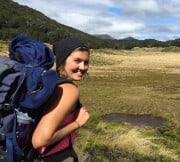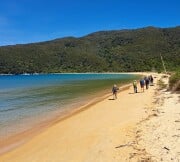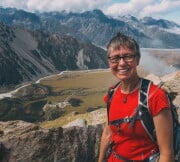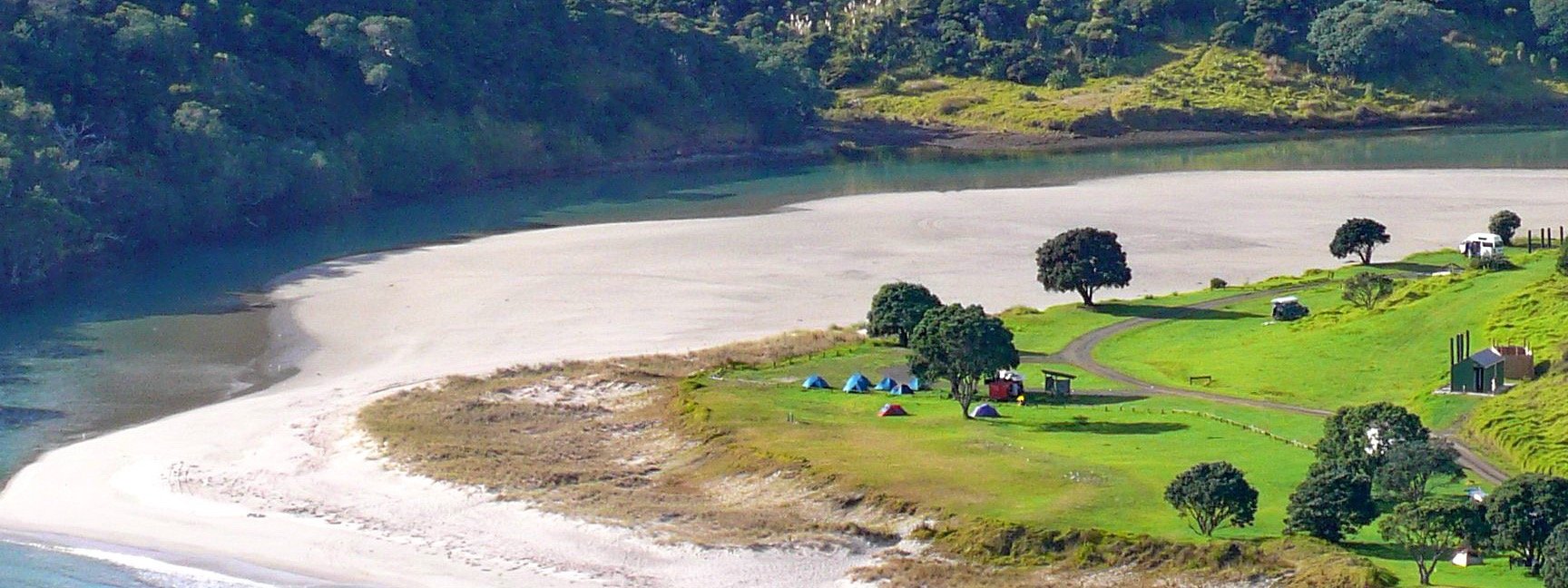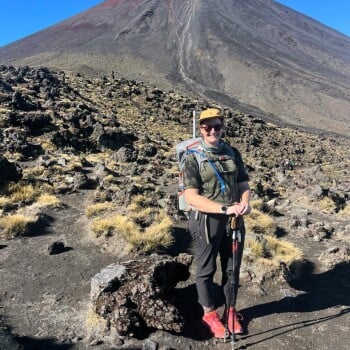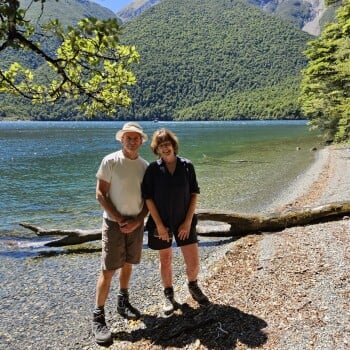
I love camping. The small yield of comfort returns a lot of enjoyment for me. It's about the beauty and simplicity of it all. Less to organise and more time to enjoy the surroundings (and the company – make sure you take good company). Having less clutter and making fewer decisions means that camping is as much a break for your brain as it is recreation for your body. And good gear helps - soft air beds, affordable waterproof tents and so on...
In general when camping, if there is an official campsite with a loo you should use it. But in remote areas where there is none, bury your poop properly and leave the place better than you find it taking all rubbish with you. Help keep the good name of campers intact!
Tapotupotu - The Far North (Department of Conservation basic camp)
- Vehicle access, cold showers, loos, water, $15/$7.50.
- Unique elements: the latitude (subtropical), Pacific coast white sands, remote.
Easily found on a map just 4 km east of Cape Reinga (NZ’s top), this campsite is mid-way(ish) on the Te Paki Coastal Track.
Tapotupotu is a stunning Pacific Ocean bay with grassy campsites beside a surf beach and lagoon backed by lush forest. The first section is where the noisy big busses picnic after their Ninety Mile Beach runs (about 11 am till 2 pm), but the lagoon end is quieter and reserved for campers. DoC (bless them) have made the first area just for campervans so you get bothered less by them in the main camp. Lovely pohutukawa trees shade you and the clear blue waters of the Pacific crash onto the white sands. On summer days It could be Hawaii But on a summer night it could be Finland - the mosquitos can be very unpleasant dawn and dusk. Interestingly, Tapotupotu is the same latitude as Cape town. That explains the climate.
There is safe(ish) swimming in the lagoon for kids but the wild ocean beach (usually more sheltered at the northwest end) can have rips. There’s no one up here to rescue you.
It is a long way from any town (over an hour from Kaitaia) so this beautiful place gets mainly day picnickers (other than Christmas/New Year) so is usually not overcrowded at night.
 Tips
Tips
- Check the DoC website for updates - especially water supply status.
- The nearest shop is a long long way away.
- If you are not ocean-beach wise don't swim here, people drown. Just because others are swimming doesn't mean you are up to it. Can everyone do an olympic ski jump? Nope.
- Floating up the lagoon on an incoming tide is fun.
Waiharuru Hut – Lake Waikaremoana Great Walk campsite
- Lakeside grassy clearing with loos, water, swimming, and a nearby hut to shelter in. Walking access only to here. No vehicle access. $15/$7.50
- Unique elements: the forests are endless, untouched, primordial. Are we in Borneo?
This hut/camp is about 3-4 hours hike on a good trail from the northern end of the 3-4 day Lake Waikaremoana Great Walk in Te Urewera (3-4 hour’s drive east of Rotorua).
This is utterly remote Tūhoe tribal country of bright blue lakes floating on oceans of forests. Lake Waikaremoana is the North Island’s deepest lake and is surrounded by mountains and native forest. The Urewera area is its own legal entity managed by the local tribal authority on its behalf. Get updates from them on water taxi, hut, camp and road conditions before beetling here on the long and windy road (see tips).
Waiharuru is my favourite camp on this multi-day hike. The substantial grassy clearing is right beside the lake, but unlike most campsites beside a hut, here you feel that the campers got the primo spot! The hut is a good 20 metres away hidden behind a ditch and clumps of toe toe bush. Campers get a little beach, lake views, and some shelter if it's windy.
Lake Waikaremoana’s water level has been managed for hydroelectricity generation for about 70 years, sadly to the detriment of the beaches. As the water rises (and falls) many beaches here go from lake-bed mud to sand-silt then, as the water gets higher, to swamped trees. This beach always seems to be reasonable no matter what the lake level is. I lament at how beautiful the beaches would have been before the hydro-crowd turned up.
 Tips
Tips
- The walk from the water taxi drop off/northern road end to here is a very enjoyable section and quite straightforward, so would suit a there-and-back hike, and is kid-friendly.
- There is a small camp shelter for cooking (which has a water tank but it rarely works). I use the lake water (but if you are worried about the swan poo just go to the hut for drinking water).
- A tribal authority manages this area so don't expect it to be DoC (or call it a National Park - it's not). Plenty of information out on the web has either not been updated or seems to struggle with the idea that Te Urewera is now broken into a landscape of contiguous (and different) tribal authorities who assist the land to manage itself. You are manuhiri (visitors) here and welcomed. It's full-on tangata whenua (including the Maori language), so enjoy this rare and wonderful New Zealandness.
- The other site I quite like on this walk is by Waiopaoa Hut.
Trounson Kauri Park campsite - The Far North (Department of Conservation basic camp)
- Vehicle access, showers (sometimes warm!), flush loos, water, great camp kitchen, kiwi spotting. $20/$10
- Unique elements: wild kiwi birds ‘storming’ around!
You will probably need a reasonable map to find this spot (cache Google Maps). It’s about 10km southeast of the famous Waipoua kauri forests (opposite coast from Whangarei City). A split-off road (with ambiguous intersections) from Highway 12, takes you inland then parallel to Highway 12, and the magnificent Trounson Kauri Park is on the route. If you continue north or south (the next day) you get spat out back onto Highway 12.
I like this place because it's nice camping (once again the big campervans are requested to keep off the camp area), it has bushy grassy shady sites and has nice facilities for a DoC camp. I really love this place because you hear and sometimes see wild kiwi birds stomping around at the camp! This is unique.
The reserve is about 600ha of stunning mature kauri forest that’s been around since time immemorial. The easy boardwalk loops through a small section of this once stunning forest (kauri dieback is really taking hold now). Do a night-walk and listen for kiwi crashing around, then shine your red-filtered torch to see them. I have been here about 30 times and more than half my trips I have been lucky enough to see these bizarre creatures. Evolution has not equipped kiwi for encounters with a bipedal meat-eating mammal (us) - so they often just curiously look back, before continuing to probe for food near your feet! No “will this creature eat me?” thoughts seem to occur in their bird brains.
 Tips
Tips
- Quite busy in summer so perhaps book. Suggest to the campervans to return to the gravel if they are crowding tents out and you can't find any grass to camp on.
- Take red cellophane to cover your flashlight with (find some at The Warehouse, or use a red plastic bag) - leave it behind pinned on the camp notice board for others to use later.
- Although many say it’s best to go kiwi spotting as late as possible at night and be super quiet when sneaking around, in my experience neither of these techniques seems to guarantee success! I've blundered around Trounson looking for kiwi barely past dusk and been quite successful on occasion!
Lake Tarawera Hot Water Beach (Department of Conservation basic camp)
- Walk 4 hours or kayak/water taxi access. Lakeside camping, loos, camp shelter, swimming, thermal emissions. No vehicle access. $15/$7.50
- Unique elements: thermal springs and steam vents, camping in a ‘crater’ lake.
Lake Tarawera is 10 km southeast of Rotorua off the main drag on a dead-end road. This is a forest-lake-volcano gem! Hot Water Beach camp is at the east end of the Tarawera Trail at Te Rata Bay. It’s always been a small and busy campsite serving boaties, but now the walking trail gets here too. These days you have to book, so it’s no longer a zoo of busyness (at night time anyway). This is one of those places you should probably let go of any aspirations for peace and quiet, but it is still a lovely and fascinating place.
I suggest you hike one way and get the water taxi back. The walk is simply splendid.
If you walk make sure you sniff out the detour to the little hot pools at the lake's edge (where Wairua Stream comes out) about an hour from the campsite (you can also pop around by boat from the camp).
 Tips
Tips
- No water other than lake water (but it’s ok quality – probably not for drinking as is but fine to boil or treat).
- Boaties and booze show up here.
- Book well in advance for holidays and weekends using the DoC website.
- The active thermal emission on the lake edge is a bit frustrating as the top layer is hot and it’s colder below, however, the lake itself is usually a pretty agreeable temperature for a swim.
- Swan poop alert - BTW, who introduced these birds? Or are they native after all?
- Take some time to learn the very special and sad story of this area.
- Two basic loos on the hiking trail (Wairua Stream and Kōtukutuku Bay).
- Totally Tarawera runs the water taxi – talk to them about the best place to leave your car.
Oturere Hut/camp Tongariro Northern Circuit (Department of Conservation basic camp by a hut)
- Exposed alpine camp on an old lava flow, loos, hut to cower in if it's stormy. No vehicle access. $15/free (kiwi kids) or $7.50
- Unique elements: Really alpine, get up for the incredible first light softly painting the east flanks of Mt Ngauruhoe an amazing red ochre colour. On windless mornings at sunrise, there is no place more beautiful on this earth.
This hut/camp is roughly midway along the 3-day Tongariro Northern Circuit Great Walk. Since the old Ketetahi Hut was destroyed in an eruption in 2012, Oturere Hut is now the first or last night of the tramp for most hikers (either 6 or 9 hours from a road end).
Although this camp can be devilishly exposed to the weather, and the actual camp surface is a train wreck from lack of maintenance, it’s still a beaut spot. Explore around the lovely lava blocks and sand-scapes. Great views and solitude.
15 years ago there were raised level platforms on soft ground, anchors to tie your tent guys too, and steps to sit on. DoC sadly has let this camp deteriorate (as well as the hut) and runnel erosion means it is tricky to find a flat spot that isn't a little trickle stream when it rains. Camping in the stream runnels is fine unless there is a lot of rain. However, being allowed to roam around and pitch your tent pretty much anywhere is a nice bonus.
 Tips
Tips
- Bookings are essential on the Tongariro Northern Circuit Great Walk during ‘summer’. Like all Great Walks, the rules state that you cannot free-camp on the Northern Circuit track – you have to camp at the designated sites.
- Figure out the breeze direction to find a more sheltered place, and to be upwind from the loos!
- Nearby stream (150m) has water (not drinking quality) if the hut tanks are dry.
- Good mobile reception here (but show some manners in the hut!)
- There are lots of rocks to tie tent guys to (pegs are next to useless in the ash). You can also fill stuff sacks with sand and put a big rock on top. Winds here can well exceed 100kph, check the forecast (and believe it!)

